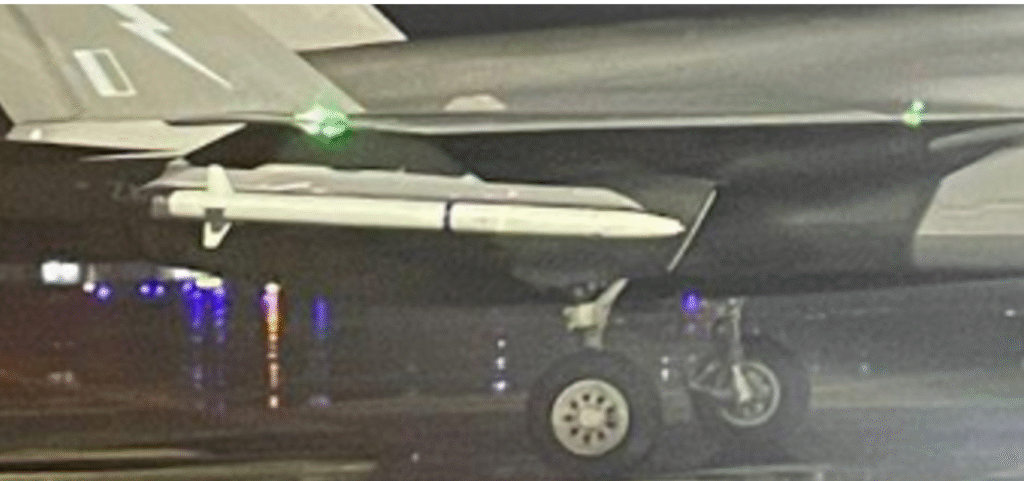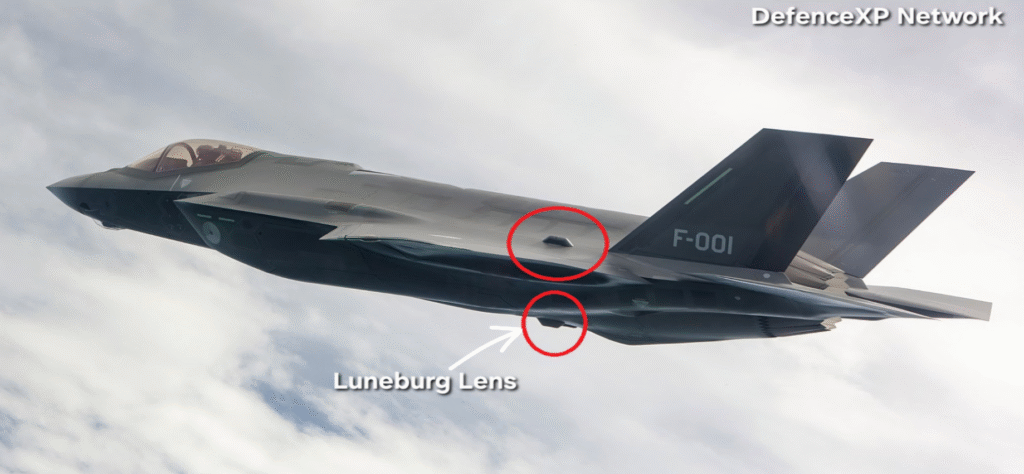How a Fifth-Generation Fighter Sparked Questions About Global Power, Geopolitics, and Technology Trust
- Timeline of a Mystery in the Making
- When SQUAWK 7700 is Activated ?
- Common Reasons to SQUAWK 7700
- Technical Malfunction or More?
- Watch: F‑35B Incident in Kerala – Full Breakdown & Hidden Clues
- Why Was the F-35B Visible to Indian Radar?
- How Missile Color Bands Reveal Operational Intent
- Theories Circulating Online (Evaluated Objectively):
- UK, US, Iran, Pakistan: Connecting the Dots:-
- Why Global Media is Strangely Quiet?
- Meme Central: Viral Jokes
- Conclusion
- F-35B Kerala Emergency: Top 5 FAQs
F-35B landing Kerala took global defense analysts by surprise. On June 14, 2025, a British F‑35B Lightning II—part of the world’s most advanced stealth jet family—unexpectedly landed at Trivandrum International Airport in Kerala, India. Officially labeled as a “fuel emergency,” the diversion of this $100+ million aircraft from HMS Prince of Wales triggered a media blackout in the West, intense speculation in OSINT circles, and a storm of geopolitical questions.
But was this just a technical hiccup—or a symbolic signal in the Indo-Pacific’s strategic chessboard?
Timeline of a Mystery in the Making
June 14, 2025, 20:50 IST: The F-35B takes off from HMS Prince of Wales, conducting PASSEX exercises with the Indian Navy in the Arabian Sea.
21:20 IST: Pilot reports low fuel and possible hydraulic failure. SQUAWK 7700 emergency transponder activated.
21:30 IST: Emergency landing at Trivandrum Airport. Cleared by Indian ATC and IAF.
June 15–20: British technicians, engineers, and a new pilot arrive. The jet remains grounded, guarded by CISF and surrounded by secrecy.
June 22: Aircraft still in open apron under heavy monsoon conditions.
June 27: The UK has accepted an offer to move the F-35B to the Maintenance Repair and Overhaul facility at the Thiruvananthapuram International Airport. UK statement: A British High Commission spokesperson said,
“A UK F-35B aircraft is awaiting repairs at the Thiruvananthapuram International Airport after developing an engineering issue. The UK has accepted an offer to move the aircraft to the Maintenance Repair and Overhaul facility at the airport. The aircraft will be moved to the hangar once UK engineering teams arrive with specialist equipment, thereby ensuring there is minimal disruption to scheduled maintenance of other aircraft.”
“The aircraft will return to active service once repairs and safety checks have been completed. Ground teams continue to work closely with Indian authorities to ensure safety and security precautions are observed. We thank the Indian authorities and Thiruvananthapuram International Airport for their continued support.”
When SQUAWK 7700 is Activated ?
● ATC radar screens flash a special emergency alert.
● The aircraft is immediately prioritized over all other traffic.
● Emergency services at the nearest airport are put on standby.
● In some cases, military interceptors may be scrambled (if unresponsive).
✈️ Explore the latest F‑35C crash details from NAS Lemoore.
Common Reasons to SQUAWK 7700
● Engine failure or fire
● Hydraulic or electrical system malfunction
● Sudden loss of cabin pressure
● Medical emergency on board
● Fuel shortage
● Navigation system failure
F-35B landing Kerala incident was marked by multiple credible sources confirming that the jet issued a SQUAWK 7700—the universal emergency transponder code—while flying off the coast of Kerala. These align with a diversion due to low fuel, consistent with the pilot’s timeline.
Technical Malfunction or More?
While the official cause cited was fuel shortage, deeper analysis suggests a more complex picture:
- The F-35B has in-flight refueling capabilities and usually flies with multiple tanker redundancies—making “low fuel” suspect.
- Hydraulic system issues were later confirmed, especially involving STOVL (Short Takeoff and Vertical Landing) actuators.
- Fuel mapping unit recalibration was necessary—indicating sensor or control system glitches.
- Similar past incidents: From the 2023 South Carolina crash to 2022’s failed vertical landing in the South China Sea, the F-35B has a pattern of operational hiccups.
Watch: F‑35B Incident in Kerala – Full Breakdown & Hidden Clues
Why Was the F-35B Visible to Indian Radar?
India’s IACCS radar network picked up the F‑35B despite its stealth pedigree. This doesn’t mark a detection breakthrough—but results from a Luneburg lens attached to the aircraft.
A Luneburg lens is a detachable radar reflector used in peacetime to increase radar visibility for civilian ATC and friendly military tracking.
Key Point: The IAF’s radar detected the aircraft, not as a stealth-defeating triumph—but as expected under non-combat flight conditions.
In the aftermath of the incident, the Indian Air Force released a statement on social media claiming it had “detected and classified” the F-35B Lightning II before permitting it to land. The announcement triggered polarised reactions online. One group of analysts celebrated the detection as a major milestone, proof that India had tracked a fifth-generation stealth jet in real time. Others pushed back, arguing that India’s Integrated Air Command and Control System (IACCS) was unlikely to have achieved such detection against a stealth platform without assistance.
🔍 Dissecting Stealth: Was the F-35B Truly Undetectable?
Let’s examine this through two lenses:
- Stage One: Was the Jet in Stealth Configuration? Imagery from the tarmac shows the jet equipped with ASRAAM missiles, including blue-striped inert rounds and a seeker head believed to be live (indicated by pink markings). However, more critically, OSINT analysts pointed out the presence of a Luneburg lens, a detachable radar reflector mounted to the jet’s underside.

Engineers have designed the Luneburg lens into a spherical device—to intentionally reflect radar waves, making stealth aircraft visible to both civilian and allied radars during non-combat or joint operations. It works by focusing incoming radar signals at a single point and reflecting them back, increasing the radar cross-section (RCS) dramatically. NATO forces commonly use it to prevent mid-air collision risk and ensure ATC compliance.

If the lens was attached and all visual signs suggest it was then detecting the F-35B was expected, not exceptional.

2. Stage Two: Misinterpretation of IAF’s Statement. The IAF said it “detected and classified” the jet, not that it did so despite stealth. If the aircraft flew with its Luneburg lens and transponders active, classification relied on standard radar signatures and signal interrogation, not breakthrough stealth detection. Many misunderstand the F-35’s “invisibility.” Designers optimize stealth jets against X-band radars used by fire control systems, while lower-frequency L-band radars detect them better. No aircraft avoids detection across all radar spectrums. The IAF’s statement was technically accurate, showing situational awareness, not proof of tracking a Luneburg-free, stealth-optimized F-35B from scratch. Stealth fighters evade radar via shaping and materials but are not invincible. Radar and detection technologies have advanced worldwide.
How Missile Color Bands Reveal Operational Intent
Photographs of the grounded F-35B in Kerala revealed a key detail that supports the theory that the jet was not operating in full stealth configuration. The aircraft was seen carrying ASRAAM missiles, with distinct blue and pink color striping:
- The blue stripe on the missile body indicates that these were inert or training rounds, not live warheads—common in peacetime joint exercises.
- The pink stripe on the seeker head suggests that the guidance system was live, meaning it was an operational seeker but not a weaponized missile.
This color coding follows NATO and UK Ministry of Defence ordnance identification standards:
- Blue band = Inert or training rounds, used for simulation and practice (no explosive warhead)
- Pink band on seeker = Live guidance or infrared sensor present, used for tracking but not impact
- Yellow band = Live high-explosive warhead (not seen in this case)
- Brown band = Active rocket motor (used in live launches)
Theories Circulating Online (Evaluated Objectively):
Amid the media silence and conflicting statements, multiple theories have circulated online—ranging from credible technical assessments to speculative intrigue. Here’s a closer evaluation of the most discussed possibilities:
Engine Malfunction (High Plausibility): F-35Bs have a history of turbine issues, particularly under marine humidity and high operational loads. A mid-flight fault involving the Rolls-Royce LiftFan or Pratt & Whitney engine could explain the sudden diversion, especially if hydraulics were also compromised.
Stealth Calibration Test (Partially Plausible): Some suggest it was an intentional move to test India’s radar detection infrastructure, potentially under a classified cooperative protocol. While speculative, such tests are not unprecedented in allied military diplomacy, especially amid shared Indo-UK drills.
UK–India Tech Signalling (Strategic Angle): The timing overlaps with growing Indo-UK defence cooperation, including joint carrier operations and potential jet engine collaboration. Was this a quiet nod to India’s inclusion in higher-tier NATO-aligned tech networks?
Spy Mission Gone Awry? (Low Credibility): Fringe theories allege that covert ISR missions near Iran or Pakistan engaged it, and detection or technical sabotage forced it to divert. While no hard evidence supports this, its unusual path over regional hotspots fuels suspicion.
Carrier Launch Abort (Operationally Likely): The most grounded theory suggests the aircraft launched from HMS Prince of Wales but could not recover due to sea state or deck malfunction, prompting a last-minute emergency reroute to the nearest secure landing zone.
While none confirm these, the information vacuum—especially in Western media—only intensifies public speculation. In the absence of transparent disclosures, even the most rational minds begin connecting dots that may not exist.
💥 Read about the previous crash of a British F‑35 fighter jet during carrier operations.
UK, US, Iran, Pakistan: Connecting the Dots:-
British aircraft carriers such as HMS Queen Elizabeth or HMS Prince of Wales routinely deploy the F-35B, and both have operated in the Arabian Sea and Gulf of Oman during recent Indo-UK naval drills. If the jet had just completed an Intelligence, Surveillance, and Reconnaissance (ISR) mission over contested airspace, its diversion path toward Kerala
becomes geopolitically significant.
India’s role in this equation is evolving. Once a neutral observer, it now stands as a strategically positioned, technology-trusted partner within emerging Western-aligned maritime frameworks. Hosting a fifth-gen jet even in emergency signals not just trust, but operational integration.
Crucially:
- The United States maintains end-to-end telemetry control over all F-35s globally. The jet’s every movement, failure, and reroute would have been known to US systems in real time. Their public silence may imply coordination or quiet consent.
- Neither Iran nor Pakistan issued formal diplomatic or military statements. Yet, if the F-35B had been monitoring regional signals intelligence or airspace, the implications for security calculus in West Asia are enormous.
In that context, this was not just a reroute. It was a momentary crossing of classified domains, a rare glimpse into the shadow theatre of allied operations across the Indo-Pacific and Middle East corridors.
Why Global Media is Strangely Quiet?
This incident has received almost no coverage from major outlets like BBC, CNN, Reuters, or even Al Jazeera. A few Indian defence handles and regional portals have reported on it, but not at scale. Even minor F-35 incidents (like canopy cracks or bird strikes) have made global news. And this begs the question, what if this wasn’t an F-35B, but another nation’s fighter jet, like an Indian, Chinese, or Russian one? Would the same global media have remained silent?In contrast, when a fifth-generation NATO-aligned jet, loaded with sensitive tech, strands on Indian soil under mysterious conditions, near-total silence follows. This disparity reflects not just editorial caution but a deeper imbalance in the global narrative ecosystem. It underscores why developing nations continue to push for strategic communication parity, especially in the defence and aerospace domains.
F-35B’s Complexity Drives Maintenance and Safety Concerns
Moreover, this incident involving the F-35 does not stand as the first. Since 2014, almost every year witnesses at least one crash or critical issue involving the aircraft, with some years such as 2022 recording up to four incidents. Even in January 2025, a notable crash occurred. When one analyses these events closely, the record clearly shows that the F-35B variant—the same model grounded in Kerala—features in a disproportionate number of these failures.
Its short takeoff and vertical landing capability, while impressive, adds significant complexity and maintenance burden. While some argue that widely deployed platforms inevitably face accidents, the F-35’s record contrasts sharply with legacy jets like the F-16 or F-15, which operate in larger global fleets yet show far fewer high-profile technical failures. Even the F-22, another stealth jet operational since 2005, has avoided such a persistent string of incidents. Even the US military is scaling back F-35 purchases.
The Kerala incident may act as a case study for operational recalibration across allied forces employing the F‑35B. Possible change in the policies and tactical implications, which includes:
Engineering Overhaul: Expect audits of hydraulic, fuel mapping, and STOVL components, with emphasis on pre-flight diagnostics and predictive maintenance.
Budget Realignment: With sustainment costs increasing, the defense ministries might demand greater transparency on logistics expenses, spares forecasting, and upgraded timelines.
Public Accountability: The recurring visibility of F-35 accidents may drive parliamentary and media oversight, especially in Europe and the Pacific Rim.
NATO Budget Push: Post the incident and rising operational expenses tied to high-cost platforms such as the F-35, NATO leadership has reiterated its demand for heightened defense budget contributions from all of its member nations like Spain which was asked to allocate 5% of its GDP in the budget.
Meme Central: Viral Jokes
The grounded stealth fighter quickly became social media’s favorite target for humor:
- The Kerala Tourism Board seized the moment, posting on social media.
- Fake OLX listings selling the fighter at bargain prices (~$4 million)

Conclusion
This event exposed aspects of fifth-generation fighter operations typically obscured from public and professional scrutiny. While intended as a quiet deployment and demonstration of strength, it ended up revealing the operational and strategic gaps still present in the F‑35B platform.
Public Image vs. Reality: The gap between branding and actual battlefield performance is becoming increasingly evident, as global public and professional skepticism intensifies—particularly with the F-35 drawing comparisons to counterparts such as the Su-57.
Future Readiness: The growing log of non-combat incidents raises questions not just about stealth but also about sustainability, resilience, and deployment ethics.
In stealth, what one often doesn’t observe matters at times. But in this case, what everyone saw mattered more. India’s effective radar detection and quiet diplomacy contrasted sharply with the silence of Western system hiccups. The F‑35B, once a poster child of aerospace innovation, faced the uncomfortable spotlight of reliability and maintainability concerns. The incident highlighted the critical importance of logistical precision in global operations and revealed that the most fragile components—whether a fuel sensor malfunction or a mid-air software fault—ultimately constrain cutting-edge platforms.
F-35B Kerala Emergency: Top 5 FAQs
1. What caused the F-35B emergency landing in Kerala?
A) The F-35B made an emergency landing due to low fuel and bad weather while returning to its carrier.
2. Why was the F-35B grounded for weeks in Kerala?
A) A hydraulic fault grounded the jet, requiring on-site repairs by UK engineers.
3. What are the strategic impacts of this incident?
A) The incident raised concerns about the F-35B’s reliability and operational challenges abroad.
4. How did the Indian Air Force assist during the event?
A) The IAF coordinated the landing, provided refueling, and ensured the aircraft’s security.
5. What financial and logistical issues arose from the grounding?
A) Extended repairs led to increased maintenance costs and logistical complexities at the airport.




